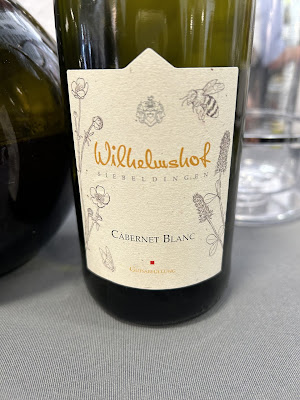This was a good SITT tasting if rare and obscure grape varieties were what you were after. Strangely enough, we were.
Here's the list:
Breslava
Dunaj
Telti-Kuruk
Albarin
Criolla Blanca
Moscatel Rosa
Jampal
According to the notice, Breslava (the historical name of Bratislava by the way) is a Slovakian cross between Chasselas Rose, Gewurtztraminer and something called Santa Maria d'Alcantara (a white berried variety of unknown origen. 'Wine Grapes' ).
It is a white grape making wine evoking Mango, Lychee and Grapefruit.
Dunaj we have come across before.
Colour Red. The notice attests to its Cherry and Dark Chocolate falvours. It is another Slovakian cross. This time between Muscat Bouschet, Blaufraenkisch and St. Laurent. Muscat Bouschet was obtained in 1857 by Pierre Bouschet by crossing Muscat Fleur d'Oranger with Petit Bouschet.
As if two new discoveries side-by-side wasn't enough, nearby we came across our favourite Ukranian wine, Shabo's Telti-Kuruk Reserve. A world class wine. A major discovery, one we have been trying to get our hands on by all means.
Not much is known about Telti-Kuruk. It doesn't appear in 'Wine Grapes.' The name is apparently Turkish although the grape is said by one source to be Armenian and everyone else to be a native Ukranian variety. Pierre Galet doesn't mention Armenia but writes that it is grown in Moldova as well as Ukraine in the regions of Odesa (where Shabo is situated) and Kherson. He states that Telti-Kuruk is a table grape and is used for sparkling wine - not something we had heard of previously.
Adam Lever, South West Area Manager of Novel wines was the representative. Thanks to him and his colleagues we had been able to buy this wine from their shop in Bristol back in February this year. You could too!
Next was Albarin, not Albarino. Scope for confusion doesn't stop there. Albarin has also been confused with Albillo, Elbling and Gouais Blanc in that all three have the synonym Blanco Verdin, and Savagnin Blanc due to mis-labelling or mis-identification in Mision Biologica de Galicia's collection.
Albillo is floral and spicy. A discovery indeed.
Matias Morcos's 'Naranja' is not made with Orangetraube. It is an Orange Wine made with Moscatel Rosa. This is a great variety, perhaps not that rare but one that should be more familiar.
Criolla Blanca. Could it be one of the many red Criollas (there are about 50 of them) vinified white or is this a rare white version? It is not mentioned in 'Wine Grapes' and is unknown to Galet.More research is required. Meanwhile we just had to reproduce the text on the back label if you can't read it in the photo above:
"Some things from the past should be cherished forever,some re-breathed and re-invented. Light and time trapped between old walls,. The courtyards, the verandas, our Grandmothers; beauty in tiny detail. The sounds that declare the silence. Peace. Those who walked before us at a calmer pace, bequeathed to us another way of living. La Cayetans celebrates the sun's heritageon the vines, and together we continue to write the history of the land."
Now we know.
This gentleman is Kevin Hart, Director of 79 North Road Ltd. He is the kindest man in the wine business. He's a rare connoisseur too. He is the only person in the UK to stock Manz's Dona Fatima Jampal. If that is not sufficient he sent us a bottle for a tasting free of charge! We are eternally grateful not just for the absence of invoice but for championing this ultra-rare variety.
Manz Wines. Dona Fatima. Jampal. Lisboa 2022. 13%
Former Brazilian soccer player André Manz bought an abandoned vineyard in Cheleiros, Portugal to make wine for himself and his friends. A commercial project was far from his ambitions at the time. On the first visit to the vineyard with an oenologist and agronomist, 200 vines of a variety were discovered which nobody was able to identify… with the help of technicians from the Instituto da Vinha e do Vinho (Vine and Wine Institute) the variety’s name was identified: Jampal.
“It is an autochthonous Portuguese variety, characteristic here in the region, but it was abandoned because it was not profitable… very sensitive, it requires a more expensive pruning and produces little quantity… we might as well have just bet on the reds and forget about it” but he persisted and produced the only monovarietal bottling of so far. There were 34 ha. in Portugal in 2016.




















































